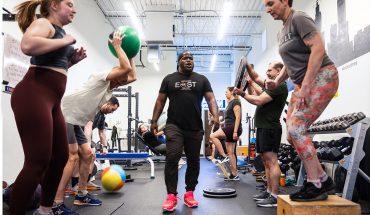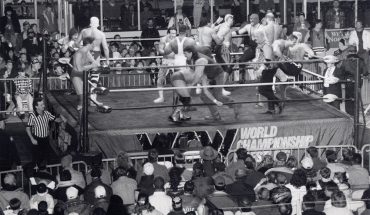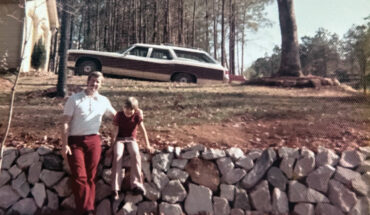An exuberant survivor of a car accident builds a new life for himself at the YMCA.
by Billy Warden | photography by Justin Kase Conder
Tony Jenkins’ charmed life fell apart on a lonely road in Alabama, scattered among the wreckage of a navy blue Mustang. He came to Raleigh to put the pieces back together.
Today, says architect Frank Harmon, “there may be no more exuberant person in the entire city.”
That gusto is on display at the Alexander YMCA on Hillsborough Street, where Jenkins, 46, works as a clean-up attendant. When he isn’t meticulously wiping down workout equipment, he’s offering piercing whoops of encouragement and raucous push-up contests.
It’s not the life that the former star architecture student and international weightlifting champion once imagined. But, following a traumatic brain injury, it’s a fate he has embraced, emerging as a different kind of star.
“In life, we all deal with things that don’t turn out well,” says Harmon of his one-time colleague. “We can either be victims or be survivors. Tony has chosen to be a survivor.”
The details of Jenkins’ fall and unlikely comeback are a mystery to many who know him. Y-goers pick up shards of the story from Jenkins himself, delivered in rapid-fire bursts as he pinballs between clean-up duties.
“Don’t drink and drive,” he declares. “I could’ve died… Other people could’ve died… But I’m here now… Best YMCA in the world!” And then he’s gone, leaving onlookers swimming in questions.
But on a recent Friday afternoon, Jenkins—his work week done—retreated to a conference room and eased into his story. Later, his father, Buck Jenkins, a former drill sergeant, filled in the gaps.
In high school, Tony Jenkins started tagging along with his dad to the gym at Fort Benning, Georgia, hoping to pack on muscle for the football team.
A weightlifting coach took note of Jenkins’ strength and low center of gravity (he stands five feet even) and recruited him. Jenkins, an Eagle Scout at 13, had always taken to challenges. Soon, the powerlifter was competing regionally, then nationally, then internationally, earning trophies and setting records.
Meanwhile, his skill as an artist earned him a scholarship to a community college. A year later, in 1996, he vaulted to Auburn University to study architecture. But when a romance unraveled his junior year, so did Jenkins. “I was doing too much,” he says. “The weightlifting, school, a job, girls…”
On an April evening in 1998, following a failed reconciliation and a few drinks, Jenkins jumped into his car and stomped the gas pedal. At a sharp curve, he lost control.
“The car flipped, sideways, end over end, many times,” Jenkins’ father recounts, his gruff voice low. “I don’t know how he survived. The wreckage looked like an airplane crash.”
A month later, Jenkins emerged from a coma into a harsh new reality. Miraculously, he had no broken bones. But the tremendous swelling of his bruised brain would permanently alter its function. Gradually, he remembered who he was. His father, by then based at Fort Bragg, brought his son to North Carolina to rehab in 1999. From talking to walking, he re-learned the basics.
“The doctors said suicide was a big threat,” the elder Jenkins remembers. “It can be extremely depressing for people when they’re young and have everything laid out in front of them, and then it’s gone.”
To be sure, Tony Jenkins had lost much. His cognitive function permanently slowed. Physical movements that once happened in a flash would forever more require focused determination. His short-term memory flickered like a faulty light bulb, and still does. Sketches that once flowed from his hand in minutes now take hours.
But for all this, Jenkins’ can-do determination remained intact. Rather than zeroing in on athletic trophies, he was determined to live independently. As soon as he was able, he hopped on city buses, eager to get out on his own and explore. Once, he stayed on a bus until it parked at the depot for the night. Police had to drive him home.
A Wake County social worker, acting on a tip from a professor at Auburn, introduced Jenkins to Harmon, who welcomed him into his eponymous firm in 2000 as an intern.
“His work at Auburn was remarkably good; he must’ve been the best in his class,” says the architect. “He was doing drawings for us, adding color to drawings. He was careful and precise. Everyone in the office loved him. But there was a limit to what he could do.”
Recognizing those limits, Jenkins opted to return to an environment he knew well: the gym. He joined the Y staff in the early 2000s. “This is the best place I’ve been in my life,” he says, then pauses, bites his lower lip and shifts gears. “I used to think I’d be married, I’d be designing homes. But I’m happy. I got a second chance.” He also eventually got his driver’s license and moved into a handsome Cary condo he helped build with Habitat for Humanity.
Monday through Friday, notebook in hand to help him remember names and tasks, he keeps the Y equipment in ship shape and the members on their toes. Architect and urban planning pundit Ted Van Dyk caps each workout by facing off with Jenkins in a duel of push ups. Jenkins is always the winner… but then, in a different way, so is Van Dyk.
“Here’s a guy who’s had this terrible injury, almost died, who comes in every day like this is the most important place in the world,” Van Dyk smiles. “If he can be so positive about it, what’s holding me back?”






